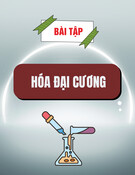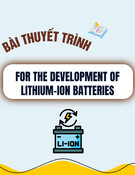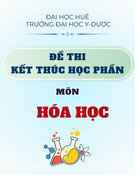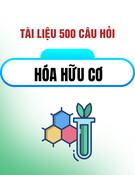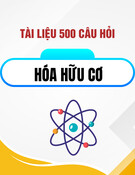
TNU Journal of Science and Technology
229(03): 96 - 103
http://jst.tnu.edu.vn 96 Email: jst@tnu.edu.vn
ESTIMATING THE WILLINGNESS TO PAY OF STUDENTS FOR
REUSABLE BAGS – A CASE STUDY AT THAI NGUYEN UNIVERSITY
OF ECONOMICS AND BUSINESS ADMINISTRATION
Nguyen Thi Thu Thuong1*, Nguyen Thu Thao1, Ha Thi Minh Hue2
1TNU - University of Economics and Business Administration
2NEU - National Economics University
ARTICLE INFO
ABSTRACT
Received:
11/10/2023
The study was conducted to determine the level of awareness, behavior
and willingness to pay for reusable bags of students at Thai Nguyen
University of Economics and Business Administration. We applied
Contingent Valuation Method and conducted a survey of 370 students
at Thai Nguyen University of Economics and Business Administration.
The estimation results showed that the willingness to pay for reusable
bags was 8,934 VND/bag. Besides, the study indicated that the majority
of students were aware of the importance of using reusable bags.
Specifically, over 80% of students surveyed responded that using
reusable bags is necessary or very necessary. In addition, we
investigated that the factors affecting the willingness to pay of students
for reusable bags, included gender, school year, living expenses in a
month, the status of part-time job, the number of times to go to the
market, the awareness of reusable bags. Additionally, some
recommendations on pricing policy, design and quality were given.
Revised:
24/11/2023
Published:
24/11/2023
KEYWORDS
Plastic bag
Reusable bag
Contingent valuation model
(CVM)
Willingness to pay (WTP)
Student
ƯỚC LƯỢNG MỨC GIÁ SẴN LÒNG TRẢ CỦA SINH VIÊN
CHO TÚI TÁI SỬ DỤNG – NGHIÊN CỨU TRƯỜNG HỢP SINH VIÊN TRƯỜNG
ĐẠI HỌC KINH TẾ VÀ QUẢN TRỊ KINH DOANH, ĐẠI HỌC THÁI NGUYÊN
Nguyễn Thị Thu Thương1*, Nguyễn Thu Thảo1, Hà Thị Minh Huệ2
1Trường Đại học Kinh tế và Quản trị kinh doanh - ĐH Thái Nguyên
2Trường Đại học Kinh tế Quốc dân
THÔNG TIN BÀI BÁO
TÓM TẮT
Ngày nhận bài:
11/10/2023
Nghiên cứu được tiến hành nhằm xác định mức độ nhận thức, hành vi và
mức giá sẵn lòng chi trả cho việc sử dụng túi tái sử dụng của sinh viên
trường Đại học Kinh tế và Quản trị kinh doanh, Đai học Thái Nguyên.
Chúng tôi đã sử dụng phương pháp định giá ngẫu nhiên (Contingent
Valuation Method) và tiến hành khảo sát 370 sinh viên của trường Đại
học Kinh tế và Quản trị kinh doanh. Kết quả ước lượng cho thấy mức giá
sẵn lòng chi trả cho túi tái sử dụng là 8.934 đồng/chiếc. Bên cạnh đó,
nghiên cứu cũng chỉ ra rằng phần lớn sinh viên đều nhận thức được tầm
quan trọng của việc sử dụng túi tái sử dụng. Cụ thể là trên 80% sinh viên
được khảo sát cho rằng sử dụng túi tái sử dụng là cần thiết hay rất cần
thiết. Ngoài ra, chúng tôi cũng tìm thấy các yếu tố ảnh hưởng đến mức
giá sẵn lòng trả cho việc sử dụng túi tái sử dụng của sinh viên, gồm: giới
tính, sinh viên đang theo học năm thứ mấy, tiền sinh hoạt phí trong một
tháng, tình trạng đi làm thêm, số lần đi chợ, mức độ nhận thức về túi tái
sử dụng. Trên cơ sở đó, nghiên cứu đưa ra một số giải pháp và khuyến
nghị về chính sách giá, thiết kế mẫu mã, chất lượng túi.
Ngày hoàn thiện:
24/11/2023
Ngày đăng:
24/11/2023
TỪ KHÓA
Túi nhựa
Túi tái sử dụng
Phương pháp định giá ngẫu
nhiên (CVM)
Mức giá sẵn lòng trả (WTP)
Sinh viên
DOI: https://doi.org/10.34238/tnu-jst.8968
* Corresponding author. Email: thuongtula.tueba@gmail.com

TNU Journal of Science and Technology
229(03): 96 - 103
http://jst.tnu.edu.vn 97 Email: jst@tnu.edu.vn
1. Introduction
The most commonly seen everyday item is a plastic bag, which has become familiar in daily
life, associated with the inherent habits of many people. With advantages like durability, strength,
convenience, and low cost, plastic bags are extensively used and are available almost everywhere
— from small shops and street markets to supermarkets and commercial centers. However, the
most significant environmental harm posed by plastic bags is their difficulty to decompose in
natural conditions; the decomposition process requires many years. To limit and gradually
eliminate the habit of using plastic bags and single-use plastic products, people must have a sense
of responsibility, actively participate in and organize anti-waste activities, and change habits.
Saying no to single-use plastic products is a crucial step in this endeavor.
A reusable shopping bag, sometimes called a lifetime bag in the UK, is a type of shopping bag
that can be reused repeatedly. This kind of bag serves as an alternative to single-use paper or
plastic bags. It is usually made from materials like canvas, natural fibers such as jute, woven
synthetics, or thick plastic that is more durable than a disposable plastic bag, enabling it to be
used over and over again. Reusable bags can be utilized for trips to the market, school, carrying
office lunch boxes, and holding fruits.
Turner et al. [1] suggest that willingness to pay (WTP) measures the intensity of an
individual‟s or society‟s preference for a particular good. It serves as a measure of satisfaction
when using certain goods in the market, as indicated by their WTP for that specific good. The
foundational theory of the Contingent Valuation Method (CVM) approach was proposed by
Hanemann & Kanninen [2]. This method involves answering an open-ended question, namely
whether the respondent is willing to pay a certain amount to bring about a specific change to their
status quo.
Afroz et al. [3] utilize the CVM to estimate WTP of households in Kuala Lumpur, Malaysia,
for the improvement of garbage collection services. The study applies a binary choice model to
examine the factors affecting households‟ WTP toward enhancing solid waste management. The
independent variables included in the model are age, number of family members, education,
income, and awareness of solid waste management. The study‟s results indicate that households
in Kuala Lumpur are willing to pay MYR22 for the monthly solid waste collection service.
Similarly, Kayamo [4] applied CVM and found that the citizen‟s WTP for improved solid waste
management in Hawassa city, Ethiopia was $ 0.62 per month.
The widespread consumption of single-use plastic shopping bags is a prominent factor
contributing to both environmental and socio-economic challenges on a global scale, prompting
worldwide calls for intervention strategies to cut down their usage [5]. O‟Brien [5] investigated that
gender, age, education and environmental awareness are factors affecting people‟s willingness to pay
for plastic bags. Shen et al. [6] found that young consumers‟ waste sorting experience and perceived
social worth have positive effect on young consumers‟ intention to pay for shared express packaging
in China. Besides, the Arriagada et al. [7] showed that avoidance of plastic consumption is
influenced by gender, age, environmental awareness, environmental involvement, participation in
environmental causes, and pro-environmental behaviors.
The Dunn‟s study [8] employs a conventional dichotomous choice contingent valuation or
stated preference technique to assess two key aspects. Firstly, it aims to gauge the average
household's WTP for persisting with plastic bags instead of opting for reusable bags. Secondly,
the study aims to ascertain the Willingness to Accept (WTA) values of consumers who already
occasionally use reusable bags for certain shopping trips. The study reveals that individuals who
currently utilize reusable bags for a portion of their shopping outings would be inclined to adopt
reusable bags for all their shopping trips if they are compensated with $0.12 for each reusable
bag they personally brought along. Furthermore, the study‟s findings underscore the impact of a
modest tax on plastic bags. The implementation of this tax demonstrates a substantial reduction
in the consumption of plastic bags.

TNU Journal of Science and Technology
229(03): 96 - 103
http://jst.tnu.edu.vn 98 Email: jst@tnu.edu.vn
Similarly, Madigele et al. [9] conduct a study utilizing a double-bound CVM to assess
consumers‟ preferences regarding plastic bag usage and their willingness to consider more
environmentally-friendly alternatives [9]. The study shows a significant relationship emerged
between the respondents‟ level of education and gender with their WTP for ongoing plastic bag
usage. Furthermore, the research indicates significant variations in income and education levels
with respect to environmental awareness. Importantly, the study also reveals a crucial quantitative
aspect: the average estimated price for a single 25-liter plastic bag is determined to be BWP0.44.
In Vietnam, Nguyen Van Song et al. [10] use the CVM method to determine the WTP of the
farmer households for the service of collection, management and treatment of domestic solid
waste in Gia Lam district, Hanoi. The research results show that the variables that have a positive
impact on WTP are income, age, education level, occupation, and gender. The variable that has a
negative effect on WTP is the number of people in the household. By the weighted average
method, this study has determined the average WTP of the farmer household as WTP = 6,000
VND/month.
Similarly, Nguyen Van Ngai et al. [11] utilize the CVM method to determine the WTP of
individuals in Cao Lanh city, Dong Thap province, for clean water supply services. The authors
surveyed 172 randomly selected households without access to clean water from the city‟s water
supply system. They employ a linear regression model using the least squares method to identify
the factors influencing a household‟s WTP. The research findings reveal that seven independent
variables affect WTP: education level, household size, total income, address of the household head,
number of employed people, water source, and environmental awareness. The calculated average
WTP of the surveyed households for 1 cubic meter of clean water is VND 4,956.
Thai Nguyen University of Economics and Business Administration is a school with a large
number of students from many different provinces of the Northern Midlands and Mountains
region of Vietnam. The university also has many years of experience in training human resources
in the fields of Economics, Development Economics, and Investment Economics. Students are
not only potential consumers but also play an important role in spreading environmentally
protective behavior to those around them. Our research results can help shape investment projects
and develop production and business plans for manufacturers to market reusable bags that are
accessible to a wide range of consumers, thereby reducing the amount of plastic bags released
into the environment. Despite the growing popularity of these reusable bags, options designed for
students at an affordable price are not yet available on the market. Therefore, this study was
conducted to determine the willingness of students to pay for the use of reusable bags.
2. Research Methodology
In this study, the CVM method was used to determine the willingness to pay of students for
reusable bags. The approach involved applying a logit model with the following form:
Y = Ln[
] = + + + + + + + (1)
Where, is the probability of paying for reusable bags and is the student's probability
of not agreeing to use reusable bags. are the coefficients of the model; - Bid
price for 1 reusable bag; student's gender; - student's age; - student‟ academic year;
- monthly living expenses; - student's part-time employment status; - number of times
students go to the market per month; - students' awareness of reusable bags.
From the regression results, the average willingness to pay for reusable bags is estimated as
follows [2], [12], [13]:
∑
(2)
The variables used in the model are described in Table 1.

TNU Journal of Science and Technology
229(03): 96 - 103
http://jst.tnu.edu.vn 99 Email: jst@tnu.edu.vn
Table 1. Definition of variables in the logit model
Variables
Description
Measurement
P
Probability to pay for using reusable begs
The dependent variable takes the value 0 if
the respondent disagrees and the value 1 if
he or she agrees.
Bid
Bid price for 1 reusable bag
The variable gets the values of 3000, 6000,
9000, and 12000 VND/bag
Gender
Dummy variable representing the gender of
the student.
The variable takes the value 1 if the
student is male and the value 0 if the
student is female
Age
It is a continuous variable, representing the
age of the student.
The number of years
Academic year
It represents the educational level of the
students participating in the survey.
Get value 1 if students are the first-year, 2
- second-year student, 3 - third-year
student, 4 - fourth-year student
Living expenses
for a month
It is the total living allowance in a month
that the student receives from the family.
Million VND/month
Part-time
employment
status
This variable indicates the student's part-
time employment status, and whether the
students have a part-time job or not.
This variable takes the value 1 if the
student has a part-time job, 0 otherwise
Number of times
to go to the
market per month
Number of times that students go shopping
at supermarkets, markets, stores...
times/month
Awareness of
reusable bags
This variable expressing the level of
awareness among students regarding the
importance of using reusable bags as an
alternative to single-use plastic bags
The variable takes the value 0 if a student
thinks that conversion toward reusable bag
is not necessary, 2 - quite necessary, 3 -
necessary, 4 - very necessary
The survey respondents are students studying at Thai Nguyen University of Economics and
Business Administration. In 2022, the total number of students at the University was 4810
students. The study sample size was calculated based on Slovin's formula as follows:
(3)
Where N is the total number of students at the school (N = 4810), n is the number of samples
to be collected, and e is the error. Most of the studies use an error rate of 5%. Applying the above
formula, the number of samples to be surveyed is n = 370 students.
Sampling Method: The study employed a random sampling method. We conducted face-to-
face surveys with students in lecture halls and online surveys via Google Forms. The survey was
conducted for one month, from February 2022 to March 2022. The total number of survey forms
distributed was 389, and the number of survey forms received was 370.
3. Results and discussion
3.1. Characteristics of respondents
Females accounted for 58% (213 students), while males accounted for 42% (157 students) of
the total 370 students participating in the survey. We can observe that fourth-year students
constituted the largest group among the participants, with 144 students, making up 39%. They
were followed by third-year students, totaling 102 students, which accounted for 28%. Second-
year students comprised 73 students out of the 370, constituting 20%. Lastly, first-year students
represented 13% (Figure 1).
The level of concern about using reusable bags may depend on the monthly subsistence the
family provides for each student. On average, the family provides students with 0.5-1.5 million
VND per month, accounting for 20%. About 35% of students participating in the survey received

TNU Journal of Science and Technology
229(03): 96 - 103
http://jst.tnu.edu.vn 100 Email: jst@tnu.edu.vn
living allowance of 1.5-2.5 million VND per month. Next is the family's provision of 2.5-3.5
million VND/month, accounting for 31% of respondents. The lowest percentage is observed
among families offering more than 3.5 million VND per month for their children, accounting for
14%. This is equivalent to 51 out of the 370 students participating in the survey.
Figure 1. Student’s academic year
Figure 2. Percentage of students with part-time jobs
It's quite common for students to explore part-time job opportunities. The survey reveals that
62% of the participating students, corresponding to 229 out of 370 students, were currently
engaged in part-time work. In contrast, the remaining 38% of students, totaling 141 out of 370,
were not pursuing part-time employment (Figure 2). These part-time jobs expose students to new
environments, allowing them to gain both additional income and valuable life experiences.
The survey results indicate that the highest frequency category comprised students who visited
the market, supermarket, or store 5-7 times a month. This group consisted of 158 students, making
up the largest proportion among all the categories. The next highest frequency category included
students who went to markets or supermarkets 7-9 times per month. This group encompassed 89
students, accounting for 24% of the surveyed students. The third frequency category involved
students who visited these places 3-5 times per month. Among the surveyed students, 66 students
fell into this category, making up 18% of the total. The lowest frequency category consisted of
students who visited markets, supermarkets, or shops 9-11 times per month (Figure 3).
Figure 3. The frequency of students' visits to markets,
supermarkets, and shops every month
Figure 4. Students' awareness of reusable bags
When surveying the level of awareness among students regarding the use of reusable bags as
an alternative to single-use plastic bags, the majority of students (219 out of 370) stated that it is
very necessary. Additionally, 78 students indicated that transitioning to using reusable bags is
51
73
102
144
First-year Second-year Third-year Fourth-year
62%
38%
Yes No
66
158
89
57
3-5 times/
month
5-7 times/
month
7-9 times/
month
9-11 times/
month
219
78 66
7
Very
necessary
Necessary Quite
necessary
Not
necessary

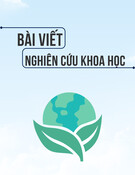
![Sổ tay truyền thông Phân loại chất thải rắn sinh hoạt trên địa bàn tỉnh Quảng Nam [Chuẩn nhất]](https://cdn.tailieu.vn/images/document/thumbnail/2025/20251114/kimphuong1001/135x160/1701763094001.jpg)
![Quản lý chất thải nguy hại: Sổ tay Môi trường [Chuẩn nhất]](https://cdn.tailieu.vn/images/document/thumbnail/2025/20251029/kimphuong1001/135x160/9011761720170.jpg)




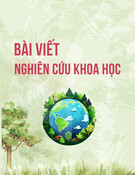

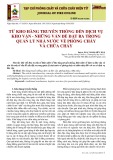
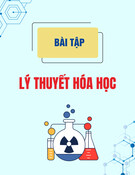
![Đề thi kết thúc học phần Nguyên lí Hóa học 2 [mới nhất]](https://cdn.tailieu.vn/images/document/thumbnail/2025/20251014/anhinhduyet000/135x160/69761760428591.jpg)
